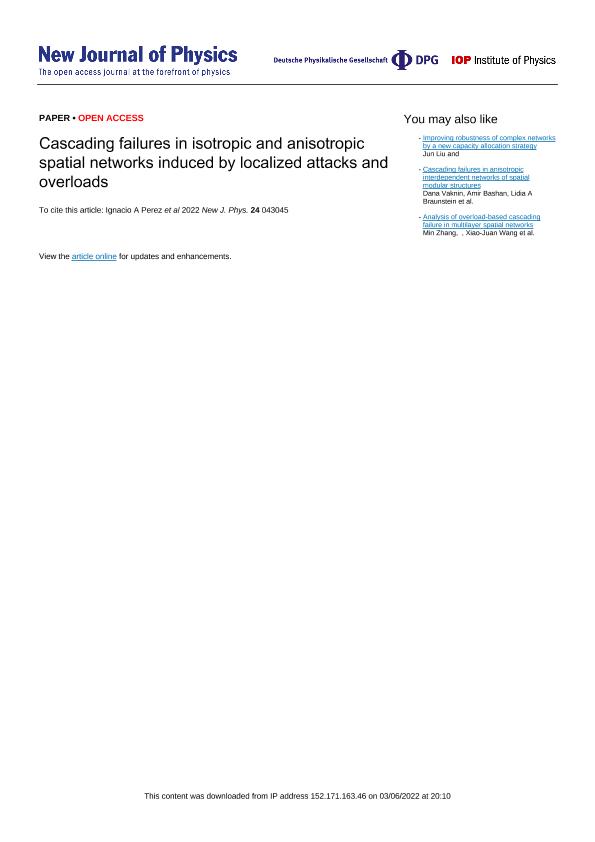Mostrar el registro sencillo del ítem
dc.contributor.author
Pérez, Ignacio Augusto

dc.contributor.author
Vaknin Ben Porath, Dana
dc.contributor.author
la Rocca, Cristian Ernesto

dc.contributor.author
Buldyrev, Sergey V.
dc.contributor.author
Braunstein, Lidia Adriana

dc.contributor.author
Havlin, Shlomo
dc.date.available
2023-09-27T14:11:49Z
dc.date.issued
2022-04
dc.identifier.citation
Pérez, Ignacio Augusto; Vaknin Ben Porath, Dana; la Rocca, Cristian Ernesto; Buldyrev, Sergey V.; Braunstein, Lidia Adriana; et al.; Cascading failures in isotropic and anisotropic spatial networks induced by localized attacks and overloads; IOP Publishing; New Journal of Physics; 24; 4-2022; 43045-43045
dc.identifier.issn
1367-2630
dc.identifier.uri
http://hdl.handle.net/11336/213189
dc.description.abstract
Cascading failures are catastrophic processes that can destroy the functionality of a system, thus,understanding their development in real infrastructures is of vital importance. This may lead to abetter management of everyday complex infrastructures relevant to modern societies, e.g., electrical power grids, communication and traffic networks. In this paper we examine the Motter–Lai model (2002 Phys. Rev. E 66 065102) of cascading failures induced by overloads in both isotropic and anisotropic spatial networks, generated by placing nodes in a square lattice and using various distributions of link lengths and angles. Anisotropy has not been earlier considered in the Motter–Lai model and is a real feature that may affect the cascading failures. This could reflect the existence of a preferred direction in which a given attribute of the system manifests, such as power lines that follow a city built parallel to the coast. We analyze the evolution of the cascading failures for systems with different strengths of anisotropy and show that the anisotropy causes a greater spread of damage along the preferential direction of links. We identify the critical linear size, lc , for a square shaped localized attack, which satisfies with high probability that above l c the cascading disrupts the giant component of functional nodes, while below lc the damage does not spread. We find that, for networks with any characteristic link length, their robustness decreases with the strength of the anisotropy. We show that the value of lc is finite and independent of the system size (for large systems), both for isotropic and anisotropic networks. Thus, in contrast to random attacks, where the critical fraction of nodes that survive the initial attack, pc , is usually below 1, here pc = 1. Note that the analogy to pc = 1 is also found for localized attacks in interdependent spatial networks (Berezin et al 2015 Sci. Rep. 5 8934). Finally, we measure the final distribution of functional cluster sizes and find a power-law behavior, with exponents similar to regular percolation. This indicates that, after the cascade which destroys the giant component, the system is at a percolation critical point. Additionally, we observe a crossover in the value of the distribution exponent, from critical percolation in a two-dimensional lattice for strong spatial embedding, to mean-field percolation for weak embedding.
dc.format
application/pdf
dc.language.iso
eng
dc.publisher
IOP Publishing

dc.rights
info:eu-repo/semantics/openAccess
dc.rights.uri
https://creativecommons.org/licenses/by-nc-sa/2.5/ar/
dc.subject
CASCADING FAILURES
dc.subject
COMPLEX NETWORKS
dc.subject
ANISOTROPY
dc.subject
OVERLOADS
dc.subject.classification
Otras Ciencias Físicas

dc.subject.classification
Ciencias Físicas

dc.subject.classification
CIENCIAS NATURALES Y EXACTAS

dc.title
Cascading failures in isotropic and anisotropic spatial networks induced by localized attacks and overloads
dc.type
info:eu-repo/semantics/article
dc.type
info:ar-repo/semantics/artículo
dc.type
info:eu-repo/semantics/publishedVersion
dc.date.updated
2023-07-07T18:34:59Z
dc.journal.volume
24
dc.journal.pagination
43045-43045
dc.journal.pais
Reino Unido

dc.journal.ciudad
Londres
dc.description.fil
Fil: Pérez, Ignacio Augusto. Consejo Nacional de Investigaciones Científicas y Técnicas. Centro Científico Tecnológico Conicet - Mar del Plata. Instituto de Investigaciones Físicas de Mar del Plata. Universidad Nacional de Mar del Plata. Facultad de Ciencias Exactas y Naturales. Instituto de Investigaciones Físicas de Mar del Plata; Argentina
dc.description.fil
Fil: Vaknin Ben Porath, Dana. Bar-Ilan University; Israel
dc.description.fil
Fil: la Rocca, Cristian Ernesto. Consejo Nacional de Investigaciones Científicas y Técnicas. Centro Científico Tecnológico Conicet - Mar del Plata. Instituto de Investigaciones Físicas de Mar del Plata. Universidad Nacional de Mar del Plata. Facultad de Ciencias Exactas y Naturales. Instituto de Investigaciones Físicas de Mar del Plata; Argentina
dc.description.fil
Fil: Buldyrev, Sergey V.. Yeshiva University; Estados Unidos
dc.description.fil
Fil: Braunstein, Lidia Adriana. Consejo Nacional de Investigaciones Científicas y Técnicas. Centro Científico Tecnológico Conicet - Mar del Plata. Instituto de Investigaciones Físicas de Mar del Plata. Universidad Nacional de Mar del Plata. Facultad de Ciencias Exactas y Naturales. Instituto de Investigaciones Físicas de Mar del Plata; Argentina
dc.description.fil
Fil: Havlin, Shlomo. Bar Ilan University; Israel
dc.journal.title
New Journal of Physics

dc.relation.alternativeid
info:eu-repo/semantics/altIdentifier/url/https://iopscience.iop.org/article/10.1088/1367-2630/ac652e
dc.relation.alternativeid
info:eu-repo/semantics/altIdentifier/doi/http://dx.doi.org/10.1088/1367-2630/ac652e
Archivos asociados
